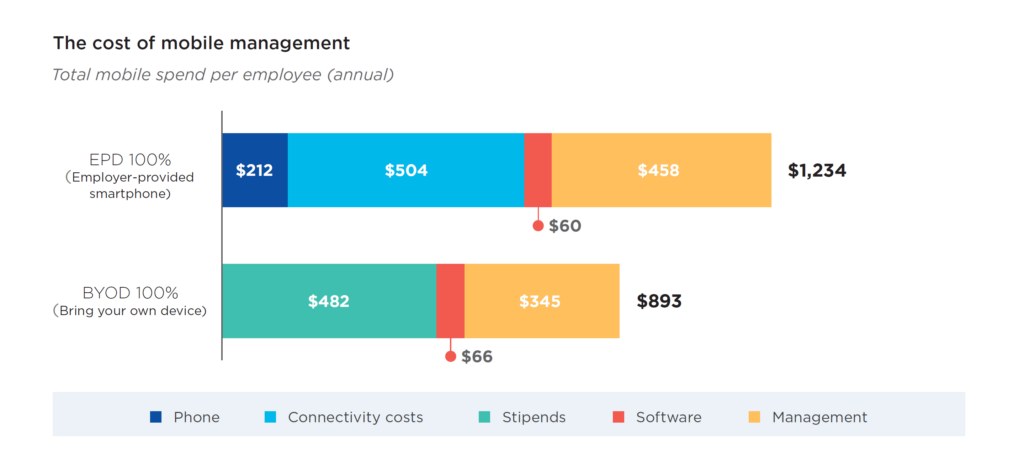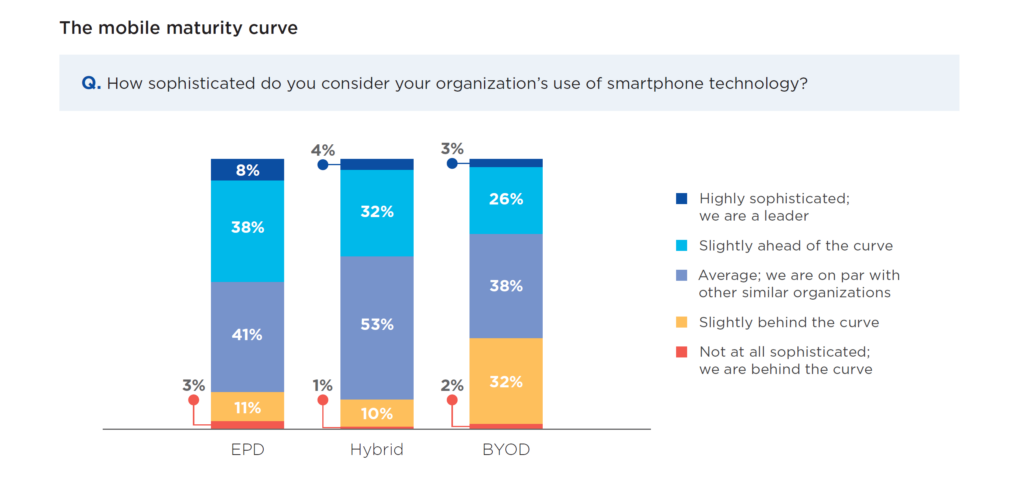In the modern workforce, virtually every new hire brings their own smartphone with them when they come on board. If they’re a good fit, you get the perfect hire plus the perfect device for keeping them connected to the office in an increasingly mobile working world.
It seems like a match made in heaven — allowing employers to save on device acquisition and carrier connectivity costs, and employees to work with a phone they’re already comfortable using. Called Bring Your Own Device (BYOD), this approach to mobile enablement has gained popularity throughout much of corporate America over the past decade. But what are the pros and cons of BYOD? And does adopting a BYOD policy actually save money for the business?
A comprehensive study from Oxford Economics, commissioned by Samsung, shows that when all the direct and indirect costs and benefits are considered, BYOD often doesn’t make as much financial sense as many business executives believe it does. To develop the study and accompanying mobile cost calculator, Oxford Economics surveyed over 500 senior IT and business leaders across a cross-section of industries, asking how they handle mobile enablement, how much they are spending and what business benefits they’re achieving. They also canvased 1,000 employees to learn about their use of smartphones for work, and the benefits and disadvantages of using a personal or corporate-issued phone.
The results show that for most organizations, adopting BYOD results in only modest savings in the total cost of mobile enablement for employees. More significantly, businesses adopting blanket BYOD policies reported obtaining the least business value from mobile.
Pros of BYOD
- Company does not have to purchase smartphones or pay for monthly mobile plans
- Employees can use a personal smartphone they are familiar with
- Slightly reduced IT workload and related device management costs
Cons of BYOD
- Cost of employee mobile stipends and time spent administering telecom expenses
- Reduced ability to manage devices and data can result in increased mobile security risk
- More complicated to deploy business apps due to multiple operating systems and device models
- Reduced business agility and customer service availability
- Correlates to increased employee turnover and reduced growth
Looking beyond mobile acquisition costs
As any IT professional involved in mobile device management knows, there’s much more to enterprise mobility than just buying phones and negotiating a cellular voice and data plan. From the device setup, configuration and security updates, to application management and ongoing support, managing mobile requires significant resources. Enterprises have large teams of internal and outside IT staff supporting their mobile programs.
The Oxford Economics study quantified the total investment made by businesses in terms of in-house human resources, outsourced support costs and enterprise mobility management (EMM) software, estimating that it represented $518 per employee per year for a 250-employee business.
Interestingly, these combined staffing and software costs reduced by only 20 percent for businesses adopting BYOD policies, compared to those issuing corporate smartphones to their employees. Just because the organization doesn’t purchase the devices doesn’t mean that it will not need to manage and secure them.
BYOD and the mobile stipend
The largest single investment for organizations issuing smartphones to employees is the monthly recurring cost of cellular voice and data plans. According to the study, this costs on average $42 a month, or $504 a year, per employee for a 250-line mobile plan.
However, the Oxford Economics study found that organizations operating a BYOD policy are taking on similar monthly costs in the form of mobile stipends paid to employees. In 2022, the average monthly stipend paid to employees came in at $40.20. This is an increase from around $36 in 2018, indicating BYOD organizations have taken on a greater share of their employees’ costs over the past few years.
 A BYOD policy can indirectly hamper efficiency
A BYOD policy can indirectly hamper efficiency
Arguably the most important statistic uncovered by Oxford Economics is also one of the most basic: how positive IT and business leaders are with the value they are getting from mobile.
Writing a BYOD policy for your business?
Get our comprehensive guide and template for developing a BYOD policy tailored to your organization. Download Now
The study found that organizations relying entirely on employees bringing their own devices are seeing the least value across virtually every metric. When compared to companies that provide devices to all employees, BYOD organizations:
- Are deploying fewer business apps, an indicator that they are less mature in their digital transformation
- Feel smartphones are less critical to agility and speed of decision-making
- Feel smartphones play a lesser role in delivering customer service and satisfaction
- Are far less likely to have mobile device management in place, putting devices and business data at risk
- Have higher employee turnover rates and lower revenue growth rates
Indeed, companies adopting a BYOD approach appear to be well aware of the negative impact it is having on their ability to benefit from mobile technology. In the survey, 34 percent of companies taking a BYOD approach admitted they are lagging when it comes to mobile maturity, more than double the rate for organizations that issue smartphones to some or all employees.
 An organization doesn’t have to be at the very beginning of its mobile rollout to consider these insights important in shaping their future decisions. Every IT and business leader should consider their approach to mobile in its totality, looking beyond the upfront savings from BYOD to the strategic value that effective use of mobile can deliver.
An organization doesn’t have to be at the very beginning of its mobile rollout to consider these insights important in shaping their future decisions. Every IT and business leader should consider their approach to mobile in its totality, looking beyond the upfront savings from BYOD to the strategic value that effective use of mobile can deliver.
Download the Oxford Economics report for more charts and data, or use our mobile cost calculator to compare your investment with the industry averages.






